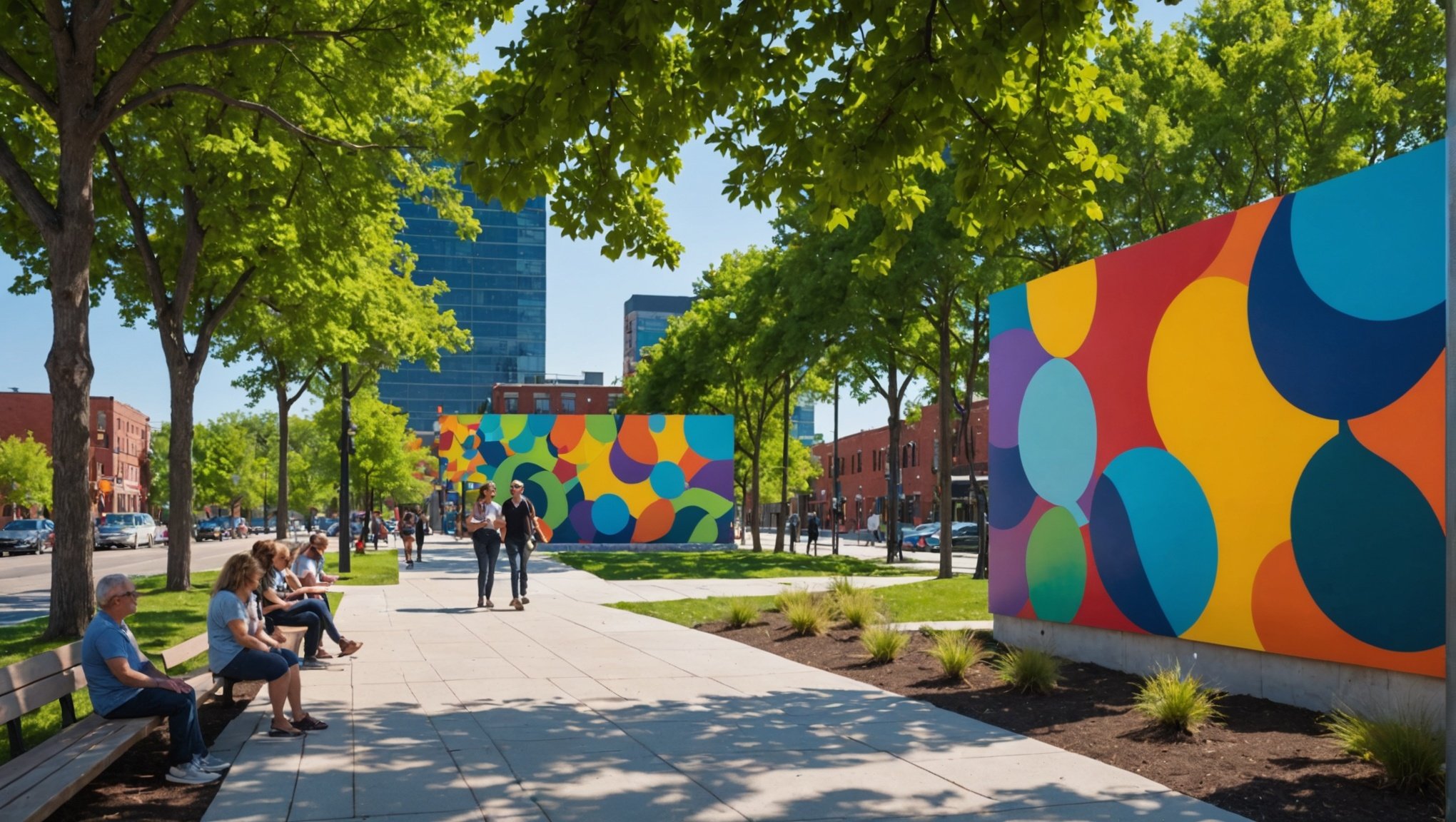Top Strategies for Seamlessly Incorporating Public Art into New Development Projects
Incorporating public art into new development projects is more than just an aesthetic addition; it’s a way to celebrate the local culture, foster community engagement, and contribute to the social and urban development of a city. Here’s a comprehensive guide on how to do it effectively.
Understanding the Role of Public Art in Urban Development
Public art is not just a decorative element; it plays a significant role in shaping the identity and character of a city. It can transform underutilized or vacant urban spaces into vibrant and meaningful areas that reflect the community’s voice and social conditions.
Also to see : Top Strategies for Ensuring Optimal Indoor Air Quality in Shopping Malls
Case Studies: Teruel, Spain, and Chengdu, China
For instance, in Teruel, Spain, and Chengdu, China, public art has been integrated into urban renewal plans to foster social being and cultural belonging. In Teruel, public art projects have focused on developing abandoned areas into spaces that enunciate the community’s voice and present social conditions. Similarly, in Chengdu, collaborations among different disciplines have ensured that artistic viewpoints are included in urban decision-making, making local communities agents of change through participatory design methods.
Community Engagement and Participation
Community engagement is crucial when incorporating public art into development projects. Here are some strategies to ensure that the community is at the heart of the process:
Also to see : Discover Cutting-Edge Strategies to Boost Air Quality in High-Density Residential Spaces
Collaborative Selection Process
In the ‘Glengall Passage’ project in South London, Artelier worked with the Southern Housing Group to involve the community in selecting the artist. Residents were presented with a shortlist of 15 artists and were able to choose their top four, ultimately selecting Ian Kirkpatrick. This collaborative approach ensured that the artwork resonated with the local population.
Participatory Design Methods
Using participatory design methods allows communities to feel ownership of urban spaces. This approach involves actively engaging with local residents, urban planners, and other stakeholders to gain insights into the specific needs and preferences of the community. For example, in the revitalization of Cheonggyecheon Stream in Seoul, South Korea, community input was crucial in integrating natural elements with pedestrian walkways and public spaces.
Integrating Public Art into Architecture and Urban Design
Public art can be seamlessly integrated into architecture and urban design in various ways, making it more interactive and engaging.
Murals and Installations
Murals are a popular way to incorporate art into architecture, both indoors and outdoors. They can be made from a variety of materials such as glass, mosaic, ceramics, metal, textiles, or paint. For instance, murals can be designed for easy installation, allowing them to be added later in a project. Additionally, public art can be incorporated into windows, ceilings, or floors, or used as functional pieces like sculptural lighting or furniture.
Digital Technology
Digital technology has opened new opportunities for artists to interact with public spaces. Public art can be created on a larger scale by projecting it onto structures, transforming existing landmarks. This approach is non-invasive, requiring only temporary rigging of projectors and lights, making it suitable for protected sites like Grade-listed buildings or heritage sites. Digital art can also incorporate changing data, such as artworks that respond to weather conditions or reflect live statistics.
Balancing Aesthetics and Functionality in Streetscapes
Modern streetscape design aims to strike a balance between aesthetics and functionality while incorporating green infrastructure and promoting walkability.
Green Infrastructure
Well-designed urban forests, tree-lined avenues, and strategically placed planters can soften the harsh lines of concrete and steel, creating a more natural and calming atmosphere. Greenery also provides shade, improves air quality, and promotes biodiversity within urban areas.
Multi-Functional Design Elements
Incorporating multi-functional design elements is key to achieving this balance. For example, rain gardens contribute to the visual appeal with lush vegetation while managing stormwater runoff. Permeable pavements enhance aesthetic appeal while facilitating groundwater recharge and mitigating urban flooding.
Overcoming Challenges: Funding, Policy, and Community Engagement
Implementing public art projects can face several challenges, including funding, policy, and community engagement issues.
Funding Strategies
Securing funding for public art projects can be challenging. However, strategies like public-private partnerships and crowdfunding can help. For instance, the High Line in New York City was transformed through a combination of public and private funding, making it a vibrant linear park and a catalyst for economic development in the surrounding neighborhoods.
Policy Support
Policy support is essential for the success of public art projects. Cities can establish policies that mandate a percentage of development budgets be allocated to public art. This ensures that public art is not just an add-on but an integral part of urban planning. In cities like Copenhagen, policy support has enabled the integration of green streets and innovative design solutions that balance aesthetic, functional, and sustainability goals.
Community Engagement Challenges
Community engagement is vital, but it can also be challenging. Ensuring that the community feels heard and involved can be achieved through regular meetings, surveys, and participatory design workshops. For example, in the case of Chengdu and Teruel, interview and survey analyses of public art perceptions helped in understanding community needs and preferences.
Measuring the Impact of Public Art
Measuring the impact of public art on urban development and sustainability goals is crucial for evaluating its effectiveness.
Qualitative and Quantitative Findings
Studies have shown that public art can have both qualitative and quantitative impacts. Qualitatively, public art can foster social being and cultural belonging, as seen in the case studies of Teruel and Chengdu. Quantitatively, public art can contribute to economic development by attracting tourists and enhancing property values. For instance, the iconic High Line in New York City has significantly boosted local businesses and property values.
Participatory Findings
Participatory findings from community engagement processes can also provide valuable insights. In a survey conducted in Chengdu and Teruel, community members highlighted the importance of community engagement, artistic quality, sustainability considerations, economic feasibility, and policy support when integrating public art into urban renewal projects.
Practical Insights and Actionable Advice
Here are some practical insights and actionable advice for seamlessly incorporating public art into new development projects:
Community-Centric Approach
- Engage the Community Early: Involve the community from the outset to ensure that the public art reflects their needs and preferences.
- Collaborative Design: Use participatory design methods to make the community feel ownership of the urban spaces.
Interdisciplinary Collaboration
- Work with Multiple Disciplines: Collaborate with artists, architects, contractors, engineers, and developers to ensure a cohesive and well-integrated public art project.
- Incorporate Local and Sustainable Materials: Use materials sourced from nearby regions to reduce the environmental impact and celebrate the local character.
Innovative Design Solutions
- Think Outside the Box: Explore innovative design solutions that combine aesthetic appeal with functional elements like stormwater management and pedestrian accessibility.
- Leverage Digital Technology: Use digital technology to create large-scale, non-invasive, and data-sensitive public art that interacts with the public.
Funding and Policy
- Secure Diverse Funding: Use public-private partnerships and crowdfunding to secure funding for public art projects.
- Establish Supportive Policies: Implement policies that mandate a percentage of development budgets for public art to ensure it is an integral part of urban planning.
Incorporating public art into new development projects is a multifaceted process that requires careful planning, community engagement, and interdisciplinary collaboration. By understanding the role of public art, engaging the community, integrating art into architecture and urban design, balancing aesthetics and functionality, and overcoming challenges, developers can create vibrant, meaningful, and sustainable urban spaces.
Key Takeaways
- Community Engagement: Engage the community early and use participatory design methods.
- Interdisciplinary Collaboration: Work with multiple disciplines to ensure a cohesive project.
- Innovative Design: Explore innovative solutions that combine aesthetics and functionality.
- Funding and Policy: Secure diverse funding and establish supportive policies.
By following these strategies, you can ensure that public art is not just an add-on but an integral part of urban planning, contributing to the social, cultural, and urban development of your city.
Table: Strategies for Incorporating Public Art into Development Projects
| Strategy | Description | Examples |
|---|---|---|
| Community Engagement | Involve the community from the outset to ensure the art reflects their needs. | Glengall Passage project in South London |
| Interdisciplinary Collaboration | Collaborate with artists, architects, contractors, engineers, and developers. | Cheonggyecheon Stream in Seoul, South Korea |
| Innovative Design Solutions | Combine aesthetic appeal with functional elements like stormwater management. | High Line in New York City |
| Funding Strategies | Use public-private partnerships and crowdfunding to secure funding. | High Line in New York City |
| Policy Support | Establish policies that mandate a percentage of development budgets for public art. | Copenhagen’s green streets |
| Integrating into Architecture | Incorporate art into architecture through murals, installations, and digital technology. | Murals in Teruel, Spain |
| Balancing Aesthetics and Functionality | Use multi-functional design elements like rain gardens and permeable pavements. | Cheonggyecheon Stream in Seoul, South Korea |
Detailed Bullet Point List: Key Objectives and Strategies
-
Community Engagement:
-
Engage the community early in the project to ensure their needs and preferences are reflected.
-
Use participatory design methods to make the community feel ownership of the urban spaces.
-
Conduct regular meetings, surveys, and participatory design workshops to ensure community involvement.
-
Interdisciplinary Collaboration:
-
Collaborate with artists, architects, contractors, engineers, and developers to ensure a cohesive project.
-
Involve local stakeholders and community members in the design process.
-
Use an interdisciplinary approach to integrate aesthetic, functional, and sustainability goals.
-
Innovative Design Solutions:
-
Explore innovative design solutions that combine aesthetic appeal with functional elements.
-
Use digital technology to create large-scale, non-invasive, and data-sensitive public art.
-
Incorporate green infrastructure and multi-functional design elements like rain gardens and permeable pavements.
-
Funding Strategies:
-
Use public-private partnerships to secure funding for public art projects.
-
Utilize crowdfunding platforms to involve the community in funding the project.
-
Allocate a percentage of development budgets for public art through policy mandates.
-
Policy Support:
-
Establish policies that support the integration of public art into urban planning.
-
Mandate a percentage of development budgets for public art to ensure it is an integral part of urban planning.
-
Provide incentives for developers to include public art in their projects.
-
Integrating into Architecture:
-
Incorporate art into architecture through murals, installations, and digital technology.
-
Use art as functional pieces like sculptural lighting or furniture.
-
Integrate art into windows, ceilings, or floors to make it more interactive and engaging.
-
Balancing Aesthetics and Functionality:
-
Use multi-functional design elements that combine aesthetic appeal with functional elements like stormwater management and pedestrian accessibility.
-
Incorporate green infrastructure to soften the harsh lines of concrete and steel and promote biodiversity.
-
Ensure community involvement in the design process to strike the right balance between aesthetics and functionality.
Quotes and Insights from Experts
-
“Public art is not just an add-on but an integral part of urban planning. It fosters social being and cultural belonging, and it’s crucial to involve the community in the process,” says a researcher from the study on artistic interventions in urban renewal.
-
“The integration of public art into architecture is a space-efficient and visually appealing way to make art more interactive. It requires collaboration between public artists, architects, contractors, engineers, and developers,” notes an expert from Artelier.
-
“Successful sustainable streetscapes serve multiple purposes, combining aesthetic appeal with functional elements like stormwater management, pedestrian accessibility, and ecological benefits. Community engagement is essential in achieving this balance,” highlights a report on the art and science of sustainable streetscapes.
By following these strategies and insights, developers can ensure that public art is a meaningful and integral part of new development projects, celebrating the local culture, fostering community engagement, and contributing to the social and urban development of the city.






